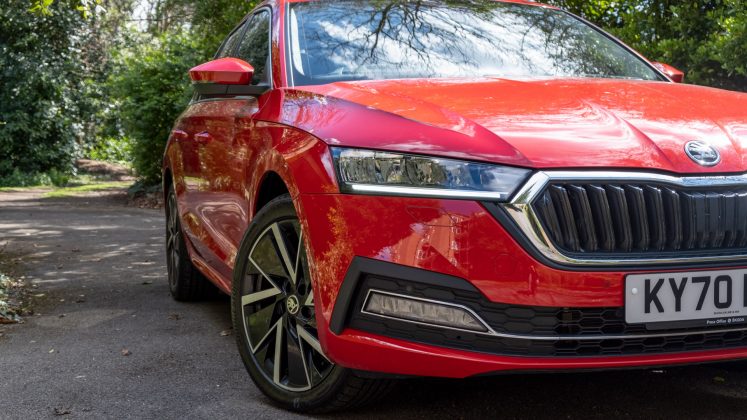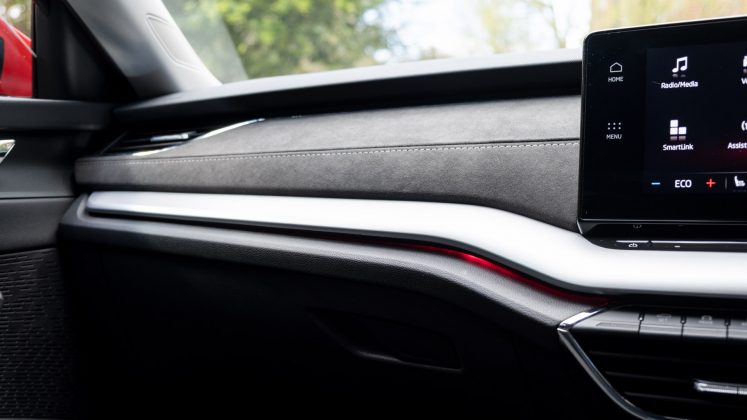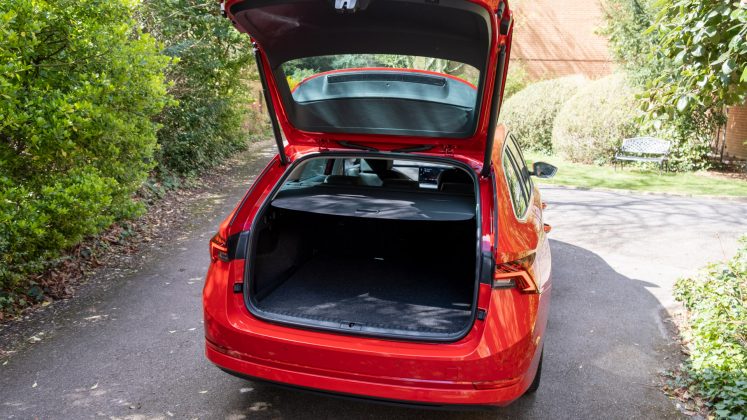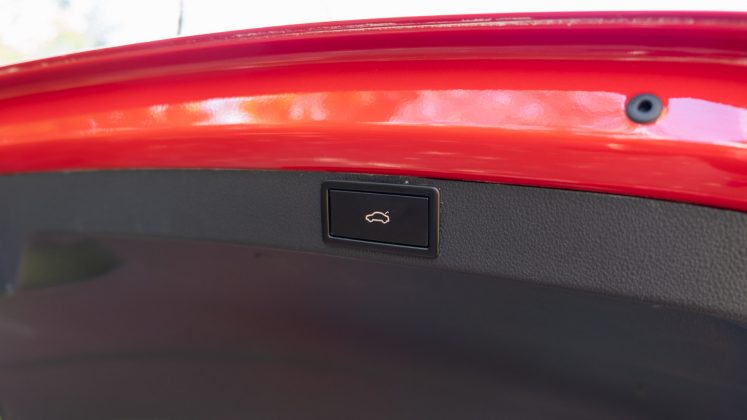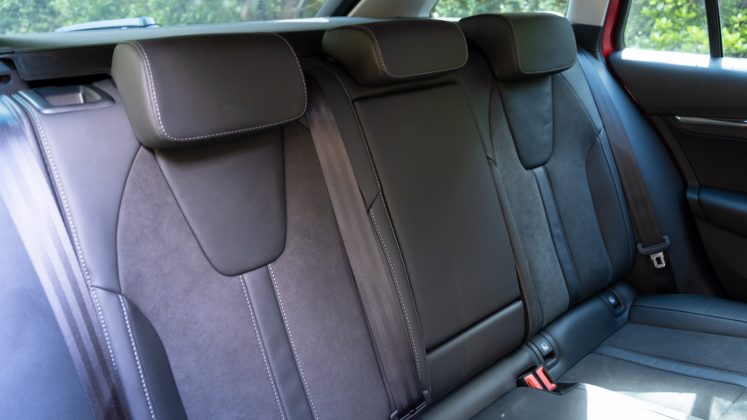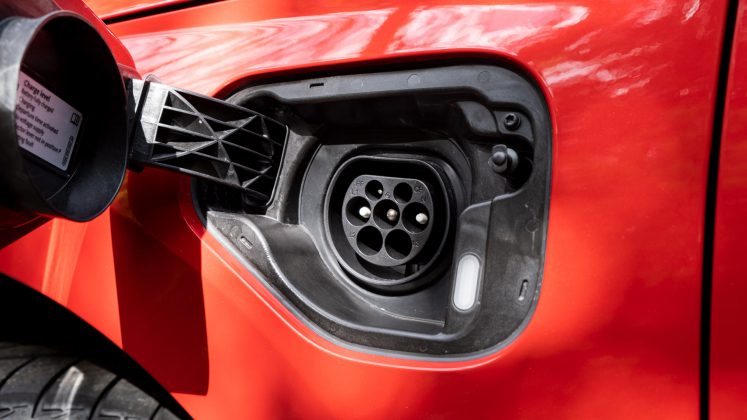Skoda’s history stretches back to 1895, where it started life as a bicycle manufacturer operating under Laurin & Klement; it was named after its founders, Václav Laurin and Václav Klement.
The manufacturer later started production of automobiles and after it was acquired by Škoda Works in 1925, it underwent numerous changes, wherein 2000 it became a wholly-owned subsidiary of the Volkswagen Group.
The Octavia iV is available in both a hatchback saloon and an estate. Both are available in the SE L (Skoda’s premium trim) and vRS configuration. The latter adds more power and a sportier flair. On review is the Octavia iV SE L Estate, 1.4 TSI DSG.
You can also watch the review of the Skoda Octavia iV Estate on our YouTube channel.
Skoda Octavia iV Estate price & competition
The estate starts from £34,230 and goes up to £36,875 without options for the vRS, while the hatch is slightly cheaper at £33,150 and £35,645, respectively.
As standard, the Octavia iV SE L Estate comes with the following options:
- 1.4-litre petrol engine with 85 kW motor that combined output 150 kW (201 hp) of power and 350 Nm of torque
- Six-speed DSG transmission with flappy paddles
- 13 kWh battery with a claimed 37 miles of range on the WLTP test cycle; Mode 2 & Mode 3 charging cables come included
- 18″ Vega Aero alloy wheels
- Chrome roof rails
- Rear spoiler
- LED headlights and tailights
- Electrically adjustable, heated and folding door mirrors with auto-dimming memory function
- Heated front seats
- Microsuede upholstery
- Rear privacy glass
- Keyless entry and start/stop
- Columbus satellite navigation with 10” touchscreen display and support for Android Auto and Apple CarPlay
- Instrument cluster (Virtual Cockpit) with 10.25” display
- Safety systems: Adaptive cruise control with follow to stop function; Front and rear parking sensors with manoeuvre assist; Front Assist; Lane Assist
Find the best Skoda Octavia iV deals
As for the vehicle on review, we have the following options added on top:
- Blind Spot Detection: £510
- Driver fatigue sensor: £45
- Head-Up Display (HUD): £700
- Travel Assist: £260
- Vitual pedal with electrically operated boot, child lock and LED interior light package: £840
- Exclusive colour: £975
Including VAT this takes our total tally up to £37,560, which is still cheaper than its competitors: Volkswagen’s Passat Estate GTE starts from £39,440 with the GTE Advance at £42,130 (160 kW / 215 hp); the BMW 330e SE Pro Touring starts from £41,530 (215 kW / 292 hp); the Mercedes C 300e EQ Power costs £42,069 (245 kW / 329 hp); the Volvo V60 will set you back £45,825 (253 kW / 340 hp); and the Audi A6 Avant TFSI e comes in a whopping £56,425 (220 kW / 294 hp).
Read next: Our favourite power banks for long journeys
All of these plug-in hybrids do come in at a premium versus their non-electrified siblings. However, most don’t have a like-for-like model within the same trim level; take for example the Skoda Estate SE L 1.5 TSI e-TEC that starts from £28,440, it has a total power output of 110 kW (149 hp) – move up to the Estate vRS 2.0 TDI that has a comparable power output to the hybrid iV on review and you’ll be paying upwards of £33,530.
While Skoda’s PHEV, like its competitors, is pricier than its non-electrified siblings, there are some serious savings if one is purchasing it as a company car. Benefit-in-Kind taxation for the Octavia iV SE L Estate is just 6%, with the vRS at 10%. By comparison, the Estate SE L 1.5 TSI e-TEC sits at 27% and the Estate vRS 2.0 TDI at 29%.
If you really want to cut down on your BIK tax, you could opt to go all-electric with the MG5 EV that starts from just £25,095, which will net you a rate of 0%.
Read next: Government car grant for electric cars: A complete guide on the PICG
Skoda Octavia iV Estate exterior review
Unlike the MG5 EV, however, the Skoda looks the part with aggressive Audi-esque styling from the front with its use of mean-looking headlights, flared bumper and a muscle car-like bonnet.
There’s no holding back from the side either, where you’re treated with gorgeous 18″ alloys that have a flat finish in order to maximise on aerodynamic efficiency. It’s also great to see body-coloured wheel arches and sideskirts, which bolster the overall design.
At the top, there are silver roof rails, where you can opt for the £215 Roof Rack to transport larger goods. Skoda, for example, offers the ‘Black Roof Box’ that costs £395.
Around the back, it’s much of the same, where the automaker has added striking lines to accentuate the vehicle’s boot and bumper. The addition of a spoiler further emphasises the manufacturer’s desire for a sporty look. Even the taillights are angular, where they are reminiscent of its Audi sibling.
As for colour, it comes in an ‘Energy Blue’ finish. Should you want the other solid colour option, ‘Corrida Red’, it’ll cost £595; the seven metallic finishes are priced the same: Black Magic Pearl Effect, Brilliant Silver, Moon White, Petrol Blue, Quartz Grey, Race Blue, and Titan Blue. The pictured ‘Velvet Red Metallic’ is an ‘Exclusive’ colour option that costs £975.
Truthfully, if you were to replace the Skoda badge with a Volkswagen or Audi one, you wouldn’t bat an eyelid. Do we have a problem with that? Absolutely not. The Octavia iV Estate is exemplary of beautiful exterior aesthetics without the premium price tag.
Read next: Volkswagen Passat Estate GTE review: The best hybrid estate?
Skoda Octavia iV Estate interior review
One might think that the Czech manufacturer would have reigned back in-cabin design but that’s anything further from the truth. It’s as if the Octavia iV Estate is a crossover between the Volkswagen Passat Estate GTE and Audi A6 Avant TFSI e; it’s both functional and stylish.
Indeed, a microsuede upholstery adds a touch of elegance throughout the cabin, while subtle uses of silver plastic elevate the dashboard and centre console design. Even the vehicle’s inner door handles are a marvel, with them looking like they’ve come out of a Danish designer’s workshop.
There’s plenty to like about the manufacturer’s use of technology, too. Propped at the centre of the dashboard is a 10″ touchscreen display that integrates Android Auto and Apple CarPlay, with the latter operating system also working wirelessly. Tested with a Samsung Galaxy S10+, Android Auto works a treat and while we’re not too fond of the screen being sectioned off with a 70:30 split, it’s still a pleasure to use.
Touchscreen sensitivity is also flawless, where there’s no delay whilst navigating through the comprehensive set of menus and options. To spruce things up, Skoda has integrated climate controls within the bottom bezel of the display; a physical ‘CLIMA’ button located below the 10″ panel also brings up the onscreen temperature controls.
We’d have preferred physical buttons and knobs, but can understand the manufacturer wanting to keep the dashboard from looking cluttered. Similarly, Skoda opts for a capacitive volume slider that stretches the length of the 10″ display. Poised by the display’s bottom bezel, you can run your finger from left to right in order to increase the volume and vice-versa. You can also tap on either side to make incremental changes to the system’s volume output.
Buy a car phone mount on Amazon (Affiliate)
On that note, the Octavia iV Estate houses an eight-speaker system. If you’d like to hear how it sounds, head on over to our YouTube channel for the dedicated review. You can also opt for the 12-speaker Canton sound system for £590, although, you’re oddly required to add the £870 Virtual Pedal and £265 LED interior light pack options – tallying up to £1,725 – to allow you to add the sound system to your desired configuration.
In order to interact with your media, there’s the volume slider on the dashboard, onscreen buttons through the 10″ display and physical buttons found on the left-hand side of the steering wheel; a metal scroll wheel is used to adjust the system’s volume. On the other side, there are buttons and another metal wheel that allow you to interact with the instrument cluster.
The 10.25” display placed behind the steering wheel is plenty bright and can be customised to a certain degree. You can also flick through the different screens in order to set your preferred design – a map view is present, although doesn’t integrate Google Maps via Android Auto. Two LED strips on either side of the display also give you a visual representation of the remaining charge and fuel.
Should you opt for the £700 Head-Up Display (HUD), you’ll be able to view your speed, the road limit and the safety systems that are being utilised, such as adaptive cruise control and lane assist. In our opinion, it’s a great addition and also is fully integrated within the vehicle’s dashboard, which unlike the VW Passat Estate GTE, doesn’t rely on an electric mechanism that props up every time you turn on the vehicle.
Read next: Our favourite inexpensive car phone holders
Skoda Octavia iV Estate storage review
On the subject of technology, there are two USB Type-C ports found at the front and rear of the cabin. The former sits next to a non-slip tray, which is large enough to accommodate a modern smartphone – even when it’s plugged in.
Further down the centre console resides two cupholder spaces and a small area to store loose change or to place the wireless key fob. Past that, there’s an armrest, which when lifted reveals a compartment to store a wallet or small-sized purse. Should you have a larger purse or larger valuables, you can store them in the glove compartment or within the fabric-finished door compartments where you’ll also be able to place a 500ml bottle. Oddly, a Chilly Bottle won’t fit within the centre cupholder spaces, however, a reusable coffee cup or a small fizzy drink bottle can fit.
As for boot capacity, there’s 490 litres with the seats up and 1,555 litres with them folded flat; that’s down from the non-hybrid model that offers 640 and 1,700 litres, respectively. It’s also slightly smaller than the VW Passat Estate GTE, which offers 483 and 1,613 litres. Still, that’s a lot of room to play around with.
Better still, we love the attention to detail at the rear of the vehicle. There are retractable hooks along the inner side, a 12V socket to provide charge, fixing points, quick release levers for the rear seats, and two small storage compartments on either side of the boot floor with removable plastic inserts that when removed, allow you to store the retractable and removable boot cover within the underfloor storage compartment. Here, you can also store your Mode 2 (Type 2 to 3-pin socket) and Mode 3 (Type 2 to Type 2) cables with ease. This, in turn, allows you to have a flat loading bay.
Should you want an electrically operated boot, it’ll cost an additional £680. A feature we feel adds to the overall practicality. You can go a step further with the addition of the £870 ‘Virtual Pedal’ option, which adds a sensor under the bumper allowing you to open the boot via a ‘kick’ function.
To bolster the vehicle’s practicality, Skoda has included a 40:20:40 split with the rear seats, which means you can bring down the middle seat or the other two should you not have any rear passengers.
Read next: MG5 EV review: The affordable fully electric estate
Skoda Octavia iV Estate comfort review
If you prefer not to have a gaping hole looking into the boot, you can leave this compartment closed and instead, have the middle seat brought down as an armrest. There are also two cupholder spaces and a place to store a few pens or crayons – a neat addition for the kids.
As for seat comfort, it’s perfect. The main four seats are finished in a microsuede material, which not only adds a bit of friction but also makes them feel a tad more premium. The rear middle seat is unsurprisingly a bit stiff and doesn’t inherit the same finish as its counterparts.
The front seats are manually adjustable – it’s a shame that electric controls aren’t included as standard, although an electrically adjustable driver seat with memory function is available as a £455 option – yet again, you’ll need to add an irrelevant £545 option in order to access this feature. No matter where you sit, headroom and legroom are plentiful throughout the cabin, where 6-foot 2-inches (188cm) individuals won’t feel henned in.
Moving onto cabin noise, the Octavia iV Estate has decent passive noise isolation from the exterior, although won’t compete with more premium offerings from Audi, Mercedes or Volvo. Thus, you’ll be able to hear tyre noise within the cabin and a bit of wind whistling past the wing mirrors and A-pillars.
Read next: The best dash cams to mount inside your vehicle
Skoda Octavia iV Estate performance review
Likewise, when it comes to performance, its 1.4-litre petrol engine combined with its 85 kW motor dispatch 150 kW (201 hp) of total power and 350 Nm of torque. While the Skoda can’t keep up with its rivals, it’ll still manage to bring a smile to your face. We launched it to 60mph from a standstill in 7.08 seconds. Top speed is limited to 136 mph.
A word of warning, however, should you floor it from a standstill, you’ll notice some front wheel spin. This is down to Skoda opting for a front-wheel-drive system, only.
The automaker also provides a six-speed DSG gearbox that allows you to smoothly go through the gears via Drive or Sport mode. This can be initiated by shifting down on the sleek-looking gear selector placed by the centre console, or manually via the flappy paddles found behind the steering wheel.
When it comes to handling, the vehicle’s body roll is kept down to a minimum, where its suspension setup is perfectly poised to take on windy country roads and equally apt to roll over speed bumps and potholes. This perfect balance also extends to the vehicle’s ability to seamlessly switch between petrol and electric power; whilst you might hear the 1.4-litre engine trickling in the background, you won’t feel it kick into life.
The hybrid switch can be customised through the infotainment system, where one can set it to charge or hold the battery, or alternatively let the vehicle decide for itself when to initiated the petrol engine via the ‘Auto’ mode. Of course, you can run in full electric mode too, but here you’ll be limited to around 25 miles. Alas, the Octavia iV Estate’s Achilles’ heel is its all-electric driving range, which doesn’t live up to Skoda’s 37-mile claim. Whilst this is disappointing, it’s on-par with the Volkswagen alternative; thus it’s not overly surprising to see the same sort of mileage from its near-identical sibling.
On the plus side, if you let the car run in hybrid mode, where it intelligently switches between the two power modes, you’ll find the vehicle recoups a respectable amount of energy back into its 13 kWh battery pack – it’s automated, where there’s no means of customising the level of regenerative braking.
Find the best Skoda Octavia iV deals
If you run out of juice its Type 2 port found underneath a flap by the passenger side front wing can take up a 3.6 kW of power. This means it’ll take around 3hrs 30mins to charge till full from empty on a public, home or workplace charger, or 5 hours when plugged into a regular 3-pin wall socket.
Being a hybrid, it also has a fuel tank that will net you around 370 miles of range – combined with its battery pack that means you can be on the road for around 400 miles without having to stop to refuel or recharge. In terms of efficiency, we found it to achieve around 55mpg in our mixed driving tests; of course, your mileage may vary depending on where and how you drive. To us, however, it’s a fantastic result where it sits close to the VW Passat Estate GTE that clocked in at around 60-65mpg.
As for its safety credentials, we were particularly impressed by the vehicle’s ability to vary its speed on the motorway via Adaptive Cruise Control (ACC). The feature can also bring you to a standstill in traffic and even safely accelerate you to the desired speed when the coast is clear.
However, Lane Assist is a little primitive, where it’ll only mildly help you steer. It’s not as sophisticated as semi-autonomous driving systems found on other vehicles on the market. Furthermore, it’s enabled by default each time you switch on the vehicle; even if you’ve disabled it on your last drive, which can be a real annoyance if you don’t like using the feature altogether. According to Skoda, this is part of the Euro NCAP safety regulations – the 2019 petrol model scored full marks in crash tests, meaning the Octavia iV Estate will similarly keep its occupants safe in the unlikelihood of a serious accident.
On the plus side, the addition of Blind Spot Detection is certainly welcome, where we found the sensors to be accurate and also the level of brightness customisable through the infotainment system. That might explain why you need to opt for the £265 ‘LED interior light pack’ in order to have access to the £510 Blind spot detection option.
When it comes to visibility, it’s excellent. This makes parking the elongated car a real breeze, even if you’re not accustomed to an estate. Here, front and rear sensors make it easy to avoid objects, although we would have liked to have seen a rearview camera fitted as standard to make life less stressful. Instead, it’s part of a £605 option which also adds dynamic indicators to the rear LED lights.
Read next: BMW 330e M Sport Touring first drive: The ultimate hybrid estate?
TotallyEV’s verdict on the Skoda Octavia iV Estate
On the whole, there’s very little to dislike about this Skoda. The Octavia iV Estate is an excellent plug-in hybrid that undercuts its rivals and looks the part, too. While it isn’t fully electric nor offers the range we’d expect from a modern PHEV, it’s hard to deny that the Czech manufacturer offers plenty of bang for your buck – the Octavia iV Estate is practical, stylish, fun to drive, efficient and affordable.
Find the best Skoda Octavia iV deals
If you aren’t keen on making the switch to a fully electric estate, such as with the MG5 EV, it’s hard to think of a better plug-in hybrid for the price. As such, the Skoda Octavia iV Estate receives our Best Buy award.
We’d love to hear your thoughts on the Skoda Octavia iV Estate. Let us know in the comments below or via social media; we’re on: YouTube, Instagram, Facebook, Twitter and LinkedIn.




